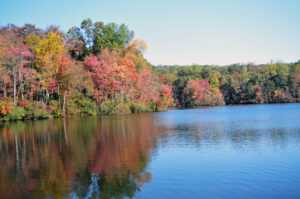Nestled along the banks of the Illinois River, Starved Rock State Park isn’t just a haven for hikers and nature lovers; it’s a paradise for wildlife enthusiasts. The park’s diverse ecosystems provide a home to a rich array of native species, offering a unique opportunity for visitors to witness the wonders of the animal kingdom. In this article, we will explore the diverse wildlife that calls Starved Rock home, from native species to migration patterns, highlighting the park’s significance as a vital habitat for various animals. Additionally, we’ll discuss the importance of practicing respectful wildlife observation.
Native Species:
Starved Rock State Park is a treasure trove of biodiversity, boasting a variety of native species that thrive within its canyons, forests, and waterways. Visitors may encounter the majestic White-tailed Deer gracefully navigating through the woods or the playful Eastern Cottontail hopping amidst the wildflowers. The park is also home to a diverse bird population, with the melodious songs of Eastern Bluebirds and the majestic flights of Red-tailed Hawks gracing the skies.
The woodlands are alive with the sounds of rustling leaves, signaling the presence of elusive creatures such as the Red Fox and Eastern Chipmunk. Reptiles, including the Eastern Box Turtle and Northern Water Snake, can be found basking in the sun near the park’s water features. Starved Rock’s diverse habitats create an ideal environment for numerous species, making each visit an opportunity to encounter the park’s vibrant wildlife residents.
Migration Patterns:
Beyond its role as a year-round habitat, Starved Rock State Park plays a crucial role in the seasonal migrations of various bird species. Located along the Illinois River flyway, the park becomes a highway for migratory birds, including warblers, waterfowl, and raptors. During the spring and fall, birdwatchers flock to the park to witness the spectacle of these journeys, as countless birds make their way through the canyons and along the riverbanks.
The park’s waterways also attract migratory fish, with species like the Channel Catfish and various types of bass utilizing the Illinois River for spawning. These seasonal movements contribute to the dynamic and ever-changing tapestry of wildlife at Starved Rock.
Habitat Preservation:
Starved Rock State Park plays a crucial role in preserving natural habitats that support a diverse range of wildlife. The park’s commitment to conservation ensures that native species can thrive within their natural environment. Preservation efforts include the restoration of native plant species, controlled burns to maintain ecosystems, and the protection of critical habitats along the Illinois River.
Respectful Wildlife Observation:
For wildlife enthusiasts visiting Starved Rock, practicing respectful wildlife observation is paramount. To minimize disturbance to the animals, maintain a safe distance, and use binoculars or telephoto lenses for a closer view. Keep noise levels to a minimum and avoid feeding wildlife, as it can disrupt natural behaviors and diets.
Consider joining guided nature walks led by knowledgeable interpreters, who can provide insights into the park’s wildlife while ensuring a minimal impact on the animals’ habitats. Responsible and informed wildlife observation contributes to the preservation of Starved Rock’s delicate ecosystems, ensuring future generations can continue to marvel at the park’s diverse wildlife.
Conclusion:
Starved Rock State Park stands as a haven for wildlife enthusiasts, offering a sanctuary for a multitude of native species and serving as a critical habitat for migratory animals. As visitors explore the canyons, forests, and waterways, they become witnesses to the beauty and complexity of the park’s wildlife. By fostering an understanding of the importance of conservation and practicing respectful wildlife observation, Starved Rock ensures that its natural wonders will continue to thrive, inviting future generations to connect with and appreciate the rich biodiversity that makes this Illinois gem a true haven for wildlife enthusiasts.


